 |
|

|
 |
TABLE of CONTENTS
 |
Summer safety goal: reduce backing incidents by 50 percent |
By JP Gillach
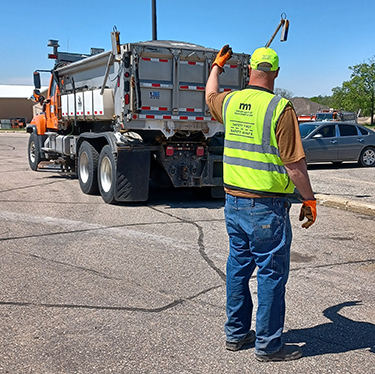
Jason Bessler, Detroit Lakes Truck Station, demonstrates proper spotter technique by standing to the rear left of the vehicle thatís backing, maintaining eye contact with the driver and communicating with hand signals that both the driver and spotter understand. Submitted photo |
Most drivers spend less than 1 percent of driving time going in reverse, yet national statistics from the National Safety Council indicate that about 25 percent of all collisions occur while backing up. With backup cameras and blind spot warnings in newer vehicles, it is easy to get complacent about backing up.
Since Jan. 1 of this year, there have been 36 reported backing incidents involving MnDOT vehicles and equipment. All of these were most likely preventable.
At a minimum, the backing incidents create an administrative burden of filling out required paperwork. But –– more important –– they also present a real possibility of injury or death. Each year, about 500 people die nationwide due to a vehicle backing over them, and more 30 percent of those deaths are children younger than five years old, according to the National Safety Council.
“This summer, MnDOT has a goal to reduce backing incidents at work by 50 percent from June 1 to Aug. 31,” said Stephanie Raley, MnDOT safety culture director. “This is an aggressive goal, but one that is easily attainable if everyone follows best practices and demonstrates safe behaviors 100 percent of the time.”
Use these tips to reduce and prevent backing incidents:
- Never assume. Don’t assume people will stop or not walk behind a backing vehicle. If you see someone in the mirror, stop until the individual is clear and in a safe position. If you have any doubt, stop backing, recheck everything and walk around the vehicle if needed.
- Know the clearances. When preparing to back up, always look for low-hanging trees, electrical wires or other potential clearance-related problem.
- Use a spotter, if available. If a reliable person is available to guide you back, use them as a spotter. Roll the window down to hear any verbal instructions or warnings. Agree on hand signals before starting. Keep the spotter in sight, preferably in the driver's side mirror. Encourage the spotter not to walk backward while giving instructions. Stop backing if the spotter is not in sight or if eye contact is broken for more than a second or two.
- Avoid distractions. Turn off the sound system when preparing to drive in reverse. Silence the phone. Remove all other distractions that can draw attention away from safely backing.
- Back slowly. Creep or use an idle speed when backing. Drivers should cover the brake with their foot and keep the backing distance to a minimum.

For more tips and guidance, review MnDOT’s Motor Vehicle and Equipment BackingSafetyDirective. This information, and all safety directives, can be found on MnDOT’sonline Workplace Safety Planner by clicking the My Safety icon on your computer desktop.
|
|
|

|
 |
TABLE of CONTENTS
 |
New District 4 overpass will address delays, safety, mobility |
By Emma Olson, District 4 public affairs coordinator
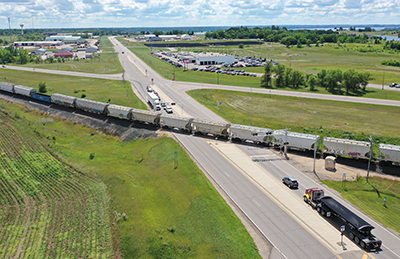
Pre-construction drone image of the Hwy 29/Hwy 55 intersection shows queuing as motorists wait for a train. Photo by Bryan Christensen |
Two trunk highways and a railroad crossing. It may sound like the setup for a good transportation joke, but it was the problem District 4 had to solve at the Hwy 55/Hwy 29 intersection near Glenwood.
In 2013, Pope County and local officials approached MnDOT with a request to address the delays at Hwy 55 and Hwy 29. The existing intersection was a four-way stop, with the Canadian Pacific Railway running parallel to Hwy 55. With the railway’s switching yard located half a mile away, trains frequently slow down through the intersection.
Nearly 6,000 cars travel on Hwy 29 each day, which resulted in long queuing during the commuting hours, and greatly impacting emergency response times. On a typical day, there are 16 or more train crossings here, delaying highway traffic by an average of four to five minutes, and sometimes as much as 11 minutes.
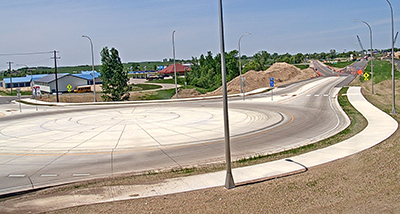
View of the completed Hwy 55/160th Street roundabout and new Hwy 55 alignment (currently closed to traffic) and overpass construction in the distance. Photo by TrueLook on-site camera |
District 4 staff supported the request for improvements and proposed an overpass on Hwy 29, spanning Hwy 55 and the railroad. During the 2018 legislative session, Rep. Paul Anderson worked to secure $10.3 million to fund the project.
The two-year construction project started in 2021, with crews working from July through October to realign Hwy 55, moving it closer to the railroad to minimize the length of the overpass. The project also involves reconstructing 160th Street, the road that will connect Hwy 55 and Hwy 29 after the overpass is constructed, and creating a roundabout at the intersection of Hwy 55 and 160th Street.
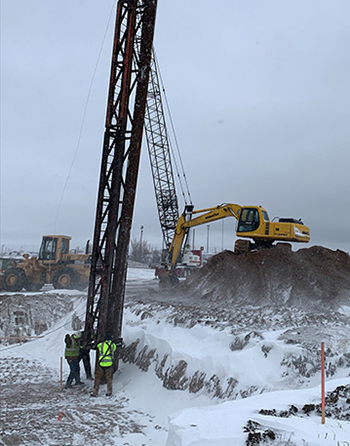
Crews drive pile in the cold and snow during the first week of construction in early April 2022. Photo by Dan Kuhn |
Work resumed in April 2022 and Hwy 29 closed north of Hwy 55.
“It felt like winter was hanging on during those first few weeks. It was cold and snowy, but they kept at it,” said Russ Floberg, District 4 construction supervisor.
Crews have now finished the north embankment, including Piers 1 and 2, and will begin on Pier 3. Work on the south side of the bridge will start in mid-June. At that time, traffic will switch to the new Hwy 55 alignment as part of the detour route, and crews will also build a second roundabout at the intersection of Hwy 29 and 160th Street.
For now, trains seem to be the only thing slowing crews down.
“Working in such close proximity to the railroad, we sometimes have to pause the work when a train comes through,” said Floberg. “It’s a challenge, but thankfully we have regular communication with CP and a contracted flagger on-site who lets us know how many trains are expected each day so we can plan ahead. It’s been a good partnership.”
Once completed, the Hwy 29 overpass will eliminate an at-grade crossing with the railroad and address mobility, safety and congestion issues. For more information about the Hwy 29 overpass project, visit the project website.
|
|

|
 |
TABLE of CONTENTS
 |
Spring floods close roads across Minnesota |
By Doug Mack
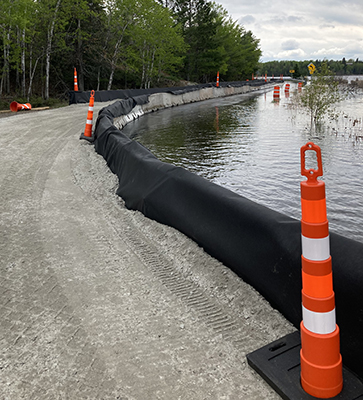
Flooding along Hwy 11 in District 1. Photo by Matt Lessard |
Heavy snowmelt and persistent rainfall have proved to be a problem around Minnesota this spring, flooding roadways in multiple districts over the last two months.
In March, the runoff from an early spring thaw raised the levels of the Red River in District 2, causing flooding and closures on Hwy 220 and Hwy 317. The same area soon had more snow and water due to a strong spring winter storm that dumped several feet of snow across North Dakota.
District 2 saw more flooding in April and May. At one point in early May, sections of seven different highways in the district were closed due to high water. District 2 Public Affairs Coordinator Leslie Seitz and Paul Konickson, District 2 Operations Engineer, gave media updates including a live segment on Mix 103.7 (KKBJ) Radio to explain information like how crews inspect each bridge to be sure the structure is without damage before reopening.
Along Rainy Lake, in District 1, historic flooding led to evacuations of some areas, and road crews did emergency work over the Memorial Day weekend to raise the grade of Hwy 11 and allow vehicular access. The efforts received media attention, including a story on Minnesota Public Radio. On the eastern edge of the district, along the North Shore, the raging Cascade River nearly shut down Hwy 61.
In the Central Minnesota, in District 3, the scenes were somewhat less dramatic, but flooding did shut down Hwy 22 south of Richmond in mid-May. For the latest information about road closures due to flooding (or any other events and conditions), check the 511 map section of the MnDOT website.
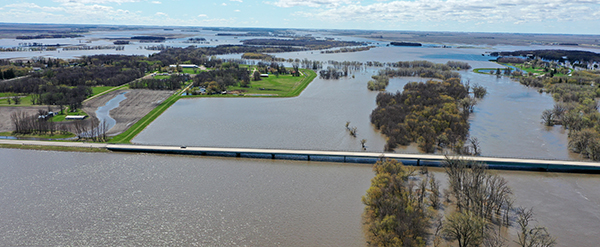
Drone shot of flooding at the St. Vincent bridge on Hwy 171, looking south. Photo by Leslie Seitz |
|
 |
TABLE of CONTENTS
 |
New newsletter offers insights on GIS |
|
By John Stasiak, District 1, and Alex Stoiaken, Office of Transit & Active Transportation
A Geographic Information System, more commonly known as GIS, is a system that creates, manages, analyzes and maps all types of data. MnDOT uses GIS in many ways, including project delivery, public outreach and data management strategies.
A new agency newsletter provides information and updates for MnDOT employees who use or are interested in GIS, and features articles on topics such as district updates, MNIT and Central Office announcements. The first issue of this quarterly publication was released in March and as more and more people at MnDOT use GIS, the GIS Newsletter will serve as an essential resource for education and connection.
To subscribe to the GIS Newsletter or view past issues, visit the GIS section of iHUB.
To get involved or to submit an idea for future articles, contact John Stasiak (Johnathon.stasiak@state.mn.us) or Alex Stoiaken (alex.stoiaken@state.mn.us).
|
 |
TABLE of CONTENTS
 |
Veterans Employee Resource Group activities honor and assist veterans |
By Rich Kemp
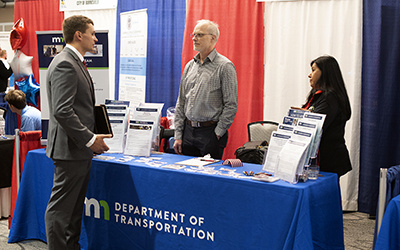
Bruce Tanquist, Office of Materials and Road Research, and Lena Garcia, Human Resources, spoke with a veteran during the Minnesota Veterans Career Fair. Photo by Rich Kemp |
The Veterans Employee Resource Group was busy in May, hosting a monthly meeting and a lunch-and-learn, and also participating in a veterans job fair.
The Minnesota Veterans Career Fair was held May 18 at the Earle Brown Heritage Center in Brooklyn Center and drew more than 300 veterans. MnDOT employees Bruce Tanquist, Office of Materials and Road Research, and Rich Kemp, Office of Communications and Public Engagement helped Lena Garcia, Human Resources, staff the agency’s booth at the event.
The lunch-and-learn, held on May 25, featured Larry Herke, commissioner of the Minnesota Department of Veterans Affairs. Before becoming the commissioner, Herke served as a member of the U.S. Army and Minnesota National Guard for more than 30 years.
Herke said that Veterans Affairs serves 304,276 veterans in Minnesota. Of these, 52 percent are age 65 or older. The service period for the veterans include:
- WWII era: 2 percent
- Korean War era: 6 percent
- Vietnam War era: 34 percent
- Gulf War (pre-9/11) era: 11 percent
- Gulf War (post 9/11): 16 percent
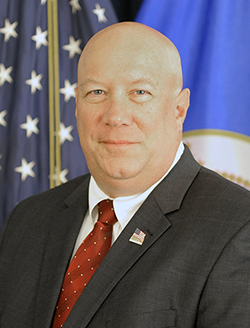
Larry Herke, commissioner of the Minnesota Department of Veterans Affairs, spoke during a Lunch and Learn May 25. Submitted photo |
MDVA serves five state veterans homes in Minneapolis, Hastings, Luverne, Silver Bay and Fergus Falls.
“We are working to end veteran homelessness,” said Herke. “The goals of MDVA are to reduce veteran suicide by 20 percent no later than 2025 and ultimately end veteran suicide by 2035.”
Herke also discussed recent state legislation, including a comprehensive veterans bill that Gov. Tim Walz signed into law May 10. The bill includes nearly $25 million for service bonuses to post-9/11 era veterans and Gold Star Families.
“This support allows us to continue serving those that have served,” Herke said, “from ending veteran homelessness and recognizing our Global War on Terrorism veterans, to supporting the ongoing operations of our state veterans cemeteries and three new state veterans homes scheduled to open in mid-2023.”
Herke ended his presentation by answering questions from MnDOT employees who participated in the event.
To learn more about the VERG, visit the group’s page on iHUB.
Memorial Day is a time to honor those who gave the ultimate sacrifice in defending their nation. It takes place the last Monday in May.
Veterans Day honors all who have served in the U.S. military. Veterans Day is celebrated every November 11.
You may find that many veterans don’t seem appreciative when they are thanked on Memorial Day. It’s because it is a time remember those who lost their lives and could not come home.
Traditionally, on Memorial Day, volunteers place small American flags on each grave site at national cemeteries. A national moment of remembrance takes place at 3:00 p.m. local time. |
|
 |
|
|
| |
 |
TABLE of CONTENTS
 |
On the Job: Byron Millea works to ensure MnDOT treats people fairly |
By Joseph Palmersheim

Byron Millea works in the Office of Civil Rights.
Submitted photo |
Byron Millea is a Title VI coordinator. He joined MnDOT six years ago, starting as a contract compliance specialist. He has worked in his current role since March 2020.
What is Title VI and why is it important?
Title VI is part of the Civil Rights Act of 1964. It prohibits discrimination on the basis of race, color and national origin in federally funded programs and activities. The Title VI program makes sure MnDOT is treating people fairly and being considerate of the ways its projects and programs may impact people.
Different people and communities have different transportation needs. For instance, people who do not have access to a car will have different transportation needs than someone who has a car. We need to understand the various types of impacts or barriers our work might have for different communities, and work to mitigate them.
Aside from the Title VI statute, regulations and guidance from federal agencies provide federal recipients like MnDOT with a roadmap for mitigating the risk of discrimination and maintaining compliance. Compliance with Title VI is a condition of receiving federal funds. MnDOT is also responsible for ensuring Title VI compliance among its federal aid sub-recipients. These include cities, counties and metropolitan planning organizations.
How does it relate to the work people do at MnDOT?
Title VI compliance impacts every area of MnDOT’s operations. Some areas have higher levels of risks than others, like construction projects. At a high level, MnDOT must work to understand how it is impacting the public and who is being affected. The greater the impact any particular program, activity or office has on the public, the greater the risks of potential Title VI issues. The better we understand the impacts, the more we will be able to identify potential disparate or inequitable outcomes. Then we can work to find project, policy or program alternatives to avoid those negative outcomes.
An area that I have focused on over the last year or so is limited English proficiency. This includes being aware of people who may need help with interpretation or translation. It's critical that people affected by a project can get information in a language or format that’s accessible to them.
One historical example that is familiar to MnDOT is the construction of I-94 and destruction of the Rondo neighborhood. This and similar displacement impacts are prime examples of what we want avoid in the future. We do that by better understanding and connecting with communities in project corridors. We can also identify opportunities to mitigate negative impacts related to displacement, noise, air quality and safety.
What do you find interesting about your job?
I have an opportunity to interact with many different offices and districts at MnDOT because of the broad scope of Title VI compliance. I enjoy the challenge of taking legal requirements and figuring out how to implement them at a large public agency like ours. Taking a resource-oriented approach to compliance allows me to act as a partner with MnDOT offices and staff. I really enjoy being able to provide helpful compliance solutions and act as a subject matter resource whenever needed.
How does your law degree relate to what you currently do?
The Title VI program is a compliance program intended to mitigate the legal risks MnDOT faces related to discrimination. Some important parts of this include:
My legal training helps me navigate these challenges. It also gives me the credibility and confidence to communicate Title VI requirements across the department.
Why did you choose law as a career and when did you become interested in it?
Quite frankly, I went to law school before I really knew what I wanted to do in the legal field. I've had an interest in history and politics since my time as an undergraduate student. I also knew that law school would provide broad opportunities in a lot of different industries. I was fortunate to end up at MnDOT through a temporary opening in the Office of Civil Rights. I am proud to have used my legal education over the last five years to work in the areas of civil rights law and compliance.
Do you or a co-worker have an interesting job to share with readers? Send us your ideas, and we’ll contact you for more information.
Recent employee profiles:
|
| |
|
| |
 |
TABLE of CONTENTS
 |
Staff deliver STEM education with bridge-in-a-bag |
By Doris Degenstein, District 7 public affairs coordinator
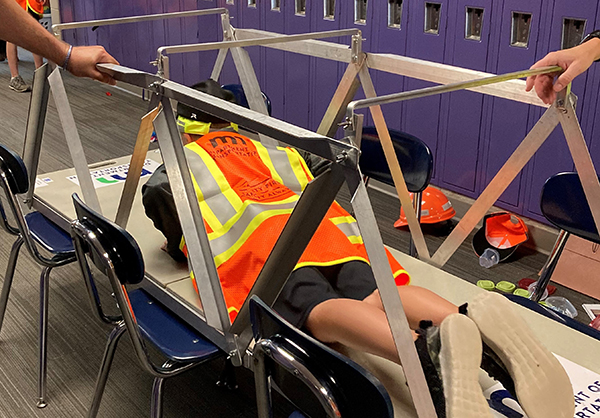
MnDOT District 7 staff used the agencyís bridge-in-a-bag activity for a fun-filled event with more than 150 third-graders students at Jefferson Elementary School in New Ulm in May. The activity is part MnDOTís ongoing efforts to help promote science, technology, engineering and mathematics to students.
Photo by Doris Degenstein |
|
| |
|
| |
|



